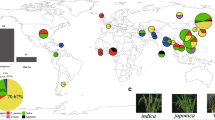Abstract.
The genetic differentiation of nuclear, mitochondrial (mt) and chloroplast (cp) genomes was investigated by Southern and PCR analysis using 75 varieties of cultivated rice (Oryza sativa L.) and 118 strains of common wild rice (CWR, Oryza rufipogon Griff.) from ten countries of Asia. The distinguishing differences between the Indica and Japonica cultivars were detected both in the nuclear genome and the cytoplasmic genome, confirming that the Indica–Japonica differentiation is of major importance for the three different classes of genome in cultivated rice. This differentiation was also detected in common wild rice with some differences among the genome compartments and the various regions. For nuclear DNA variation, both Indica-like and Japonica-like types were observed in the Chinese CWR, with the latter more-frequent than the former. No Japonica-like type was found in South Asia, and only two strains of the Japonica-like type were detected in Southeast Asia, thus the Indica-like type is the major type among South and Southeast Asian CWR. For mtDNA, only a few strains of the Japonica-like type were detected in CWR. For cpDNA, the Japonica type was predominant among the CWR strains from China, Bangladesh and Burma, while the Indica type was predominant among the CWR strains from Thailand, Malaysia, Cambodia and Sri Lanka, and both types were found in similar frequencies among the Indian CWR. Altogether, however, the degree of Indica–Japonica differentiation in common wild rice was much-less important than that in cultivated rice. Cluster analyses for nuclear and mitochondrial DNA variation revealed that some CWR strains showed large genetic distances from cultivated rice and formed clusters distinct from cultivated rice. Coincidence in the genetic differentiation between the three different classes of genome was much higher in cultivated rice than in CWR. Among the 75 cultivars, about 3/4 entries were "homoeotype" showing congruent results for nuclear, mt and cpDNA regarding the Indica–Japonica differentiation. In CWR, the proportions of homoeotypes were 5.7%, 15% and 48.8% in China, South Asia and Southeast Asia, respectively. Based on the average genetic distance among all the strains of CWR and cultivated rice for nuclear and mitochondrial genomes, the variability of the nuclear genome was found to be higher than that of the mitochondrial genome. The global pattern based on all genomes shows much-more diversification in CWR than that in cultivated rice.
Similar content being viewed by others
Author information
Authors and Affiliations
Additional information
Electronic Publication
Rights and permissions
About this article
Cite this article
Sun, .C., Wang, .X., Yoshimura, .A. et al. Genetic differentiation for nuclear, mitochondrial and chloroplast genomes in common wild rice (Oryza rufipogon Griff.) and cultivated rice (Oryza sativa L.). Theor Appl Genet 104, 1335–1345 (2002). https://doi.org/10.1007/s00122-002-0878-4
Received:
Accepted:
Issue Date:
DOI: https://doi.org/10.1007/s00122-002-0878-4




